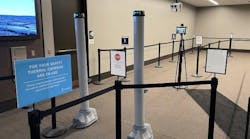BEDFORD, Mass.--(BUSINESS WIRE)--Reveal Imaging Technologies, Inc., a developer of advanced security inspection systems, announced today that it has won a research contract from the Technical Support Working Group (TSWG) with funding from the Department of Homeland Security to identify the optimal design for CT-based explosives detection systems (EDS) and to develop a hardware and software platform as a result of these findings. EDS is the TSA-certified technology currently used to screen checked baggage in the US and abroad. The investigation includes analysis of the trade-offs between CT image quality, false alarm rates and throughput. Reveal will receive up to $2.5 million for the 24 month effort.
The evaluation will include X-ray scanning techniques using image resolution that is not commercially available in any certified EDS. Reveal has partnered with Lawrence Livermore National Laboratory, the University of Michigan and Xintek, Inc. to carry out the studies and develop the optimized EDS platform.
Michael Ellenbogen, president and CEO of Reveal Imaging Technologies, said, "This program will progress in two phases. The first phase is to quantify the optimal CT configuration that will minimize the daily false alarms frequently requiring review by airport screeners. In the second phase we will utilize the findings to create a test platform for new state-of-the-art CT technology. We are excited to be working with Xintek and their advanced nanotechnology x-ray."
Dr. Otto Zhou, Chairman of Xintek, Inc., said, "Our carbon nanotube x-ray source enables multiple high resolution, fixed x-ray sources to be positioned around a CT tunnel and triggered sequentially, thereby eliminating the need for a rotating gantry. We are working with Reveal to design a test bed to investigate our technology. The intent is to develop faster scanning speeds with potentially better throughput and image quality as compared to today's EDS scanners."

